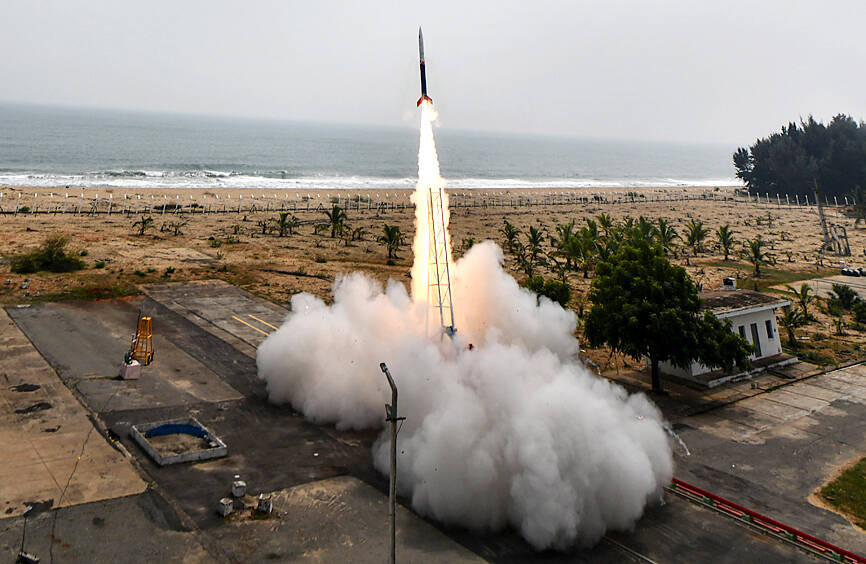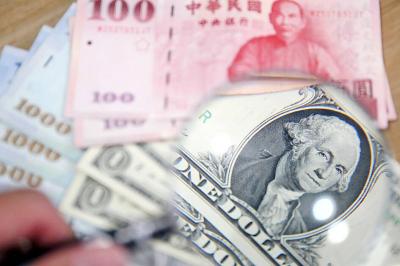The start-up behind India’s first private space launch plans to put a satellite into orbit next year, and expects to be able to do so at half of the cost of established launch companies, the founders of Skyroot Aerospace said.
The Hyderabad-based company, backed by Singapore’s sovereign wealth fund, GIC, said the US$68 million it has raised would fund its next two launches, adding that it has been in contact with more than 400 potential customers.
Thousands of small satellite launches are planned in coming years as companies build out networks to deliver broadband services such as SpaceX’s Starlink and to power applications like tracking supply chains or monitoring offshore oil rigs.

Photo: EPA-EFE
Skyroot faces established and up-and-coming rocket launch rivals that also promise to bring down costs. In China, start-up Galactic Energy put five satellites into orbit last week in its fourth successful launch.
In Japan, Space One, backed by Canon Electronics and IHI Corp, plans to launch 20 small rockets per year by the middle of the decade.
Skyroot, which launched a test rocket last week, expects to cut the cost of a launch by 50 percent compared with current pricing for established competitors such as Richard Branson’s Virgin Orbit and California-based Rocket Lab USA Inc.
Pawan Chandana, one of Skyroot’s two cofounders, said he expected a surge in demand for the company’s launch services if it proves itself with launches set for next year.
“Most of these customers have been building constellations and will be launching them in the next five years,” he said.
A push by Indian Prime Minister Narendra Modi’s administration to increase India’s share of the global space launch market from just 1 percent has given investors confidence that Skyroot and other start-ups have government backing for their efforts, Skyroot said.
“Three or four months back when we were talking to investors, one of the biggest questions they asked was if the government was supporting us,” Skyroot cofounder Bharath Daka said.
India opened the door to private space companies in 2020 with a regulatory overhaul and a new agency to boost private-sector launches.
Before that, companies could only act as contractors to the Indian Space Research Organisation (ISRO), a government space agency with a reputation of its own for frugal engineering. The country’s Mars mission in 2014 cost only US$74 million, less than the budget of the Hollywood space movie Gravity.
Building on India’s record for cost efficiency would be key, Chandana said.
Skyroot, founded in 2018 when Chandana and Daka quit jobs at ISRO, has set a target to develop rockets for one-fifth of the current industry costs.
The Skyroot rocket that reached 89.5km altitude in last week’s test launch used carbon-fiber components and 3D-printed parts, including the thrusters.
That boosted efficiency by 30 percent, cutting weight and procurement costs, although it meant Skryoot engineers had to write the machine code for vendors who fabricated the rocket because few had experience working with carbon fiber, the company said.
With 3D printing, Skyroot believes it can build a new rocket in just two days as it works towards reusable rockets, a technology pioneered by SpaceX.
Chandana and Daka believe the per-kilogram launch cost for a satellite can be brought down to nearly US$10, from thousands of dollars currently, a stretch target that could upend the economics of space commerce and one that draws inspiration from their idol: SpaceX CEO Elon Musk.
“SpaceX is a symbol of great innovation and great market validation,” Chandana said, adding that they have not had the chance to speak to Musk.
“Right now, we think he’s probably busy running Twitter,” he said.

The US dollar was trading at NT$29.7 at 10am today on the Taipei Foreign Exchange, as the New Taiwan dollar gained NT$1.364 from the previous close last week. The NT dollar continued to rise today, after surging 3.07 percent on Friday. After opening at NT$30.91, the NT dollar gained more than NT$1 in just 15 minutes, briefly passing the NT$30 mark. Before the US Department of the Treasury's semi-annual currency report came out, expectations that the NT dollar would keep rising were already building. The NT dollar on Friday closed at NT$31.064, up by NT$0.953 — a 3.07 percent single-day gain. Today,

‘SHORT TERM’: The local currency would likely remain strong in the near term, driven by anticipated US trade pressure, capital inflows and expectations of a US Fed rate cut The US dollar is expected to fall below NT$30 in the near term, as traders anticipate increased pressure from Washington for Taiwan to allow the New Taiwan dollar to appreciate, Cathay United Bank (國泰世華銀行) chief economist Lin Chi-chao (林啟超) said. Following a sharp drop in the greenback against the NT dollar on Friday, Lin told the Central News Agency that the local currency is likely to remain strong in the short term, driven in part by market psychology surrounding anticipated US policy pressure. On Friday, the US dollar fell NT$0.953, or 3.07 percent, closing at NT$31.064 — its lowest level since Jan.

The New Taiwan dollar and Taiwanese stocks surged on signs that trade tensions between the world’s top two economies might start easing and as US tech earnings boosted the outlook of the nation’s semiconductor exports. The NT dollar strengthened as much as 3.8 percent versus the US dollar to 30.815, the biggest intraday gain since January 2011, closing at NT$31.064. The benchmark TAIEX jumped 2.73 percent to outperform the region’s equity gauges. Outlook for global trade improved after China said it is assessing possible trade talks with the US, providing a boost for the nation’s currency and shares. As the NT dollar

The Financial Supervisory Commission (FSC) yesterday met with some of the nation’s largest insurance companies as a skyrocketing New Taiwan dollar piles pressure on their hundreds of billions of dollars in US bond investments. The commission has asked some life insurance firms, among the biggest Asian holders of US debt, to discuss how the rapidly strengthening NT dollar has impacted their operations, people familiar with the matter said. The meeting took place as the NT dollar jumped as much as 5 percent yesterday, its biggest intraday gain in more than three decades. The local currency surged as exporters rushed to